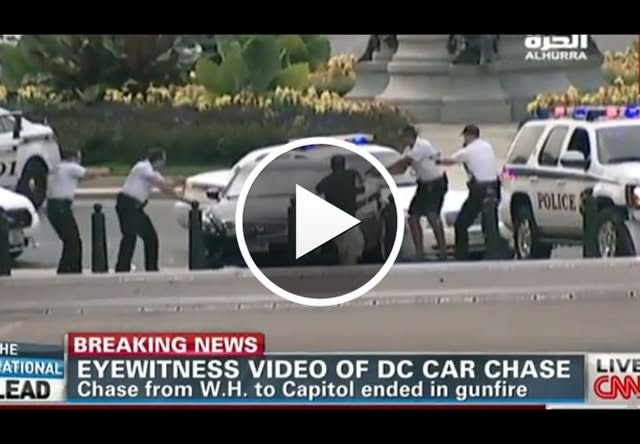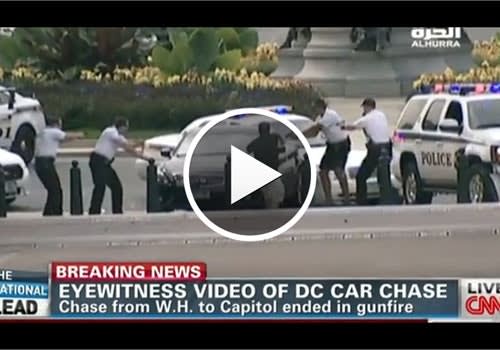Video: Justified Deadly Force In D.C.
Law enforcement's use of deadly force at the end of the U.S. Capitol pursuit may not satisfy the mainstream media or other second guessers, but it was the proper response to a lethal situation.

Law enforcement's use of deadly force at the end of the U.S. Capitol pursuit may not satisfy the mainstream media or other second guessers, but it was the proper response to a lethal situation.
Based on what we know publicly, a volatile subject attempted to breach a White House security barrier on Oct. 3 by ramming a black Infiniti into it. When the subject failed, they rammed a responding radio car, and struck a U.S. Secret Service agent. The subject then exposed the officers to great risk by speeding away at high speed in a reckless manner. The subject ultimately crashed the vehicle into a U.S. Capitol Police barricade. Officers stopped the potentially lethal threat by appropriately deploying their firearms.
Notice my reference to the individual who initiated the lethal scenario as a "subject." Responding officers were confronted by a potentially lethal threat, rather than a young attractive woman with her child in the rear seat. In assessing the appropriate level of force in this situation, gender should not be considered. All hands and feet are equally potentially lethal when applied to the steering wheel and gas pedal respectively. Inevitably, the news media's bias drew upon the subject's gender and appearance to criticize the level of force used.
Regarding the child in the vehicle, no one envies the officers who were on scene during the initial and final vehicular attacks. We don't know whether the officers were able to see the child in the back seat, especially considering window visibility factors. The officers demonstrated remarkable restraint when the subject first attempted to breach the security using her vehicle as a lethal weapon.
The presence of the child should be viewed as a potential victim of the subject's lethal behavior, and the officers should be commended for rescuing her without injury. History has shown us that subjects exuding irrational, lethal behavior have exploited children to accomplish their deadly objectives. The presence of a child, as heart wrenching as it may be, doesn't reduce the level of threat posed by the subject.
In terms of the use of deadly force, federal law enforcement officers follow the same policy and concept. We discharge our weapons as a last resort to stop a potentially lethal threat, and prevent serious bodily injury or loss of life.
Based on what is known, the officers used the appropriate level of force considering their reasonable perception of the threat level initiated by the subject. Based on her volatile use of the Infiniti, and the fact that she rammed government property and federal officers, she posed a potentially lethal threat to the officers. The subject also posed a lethal threat to those in the immediate area, including the child in her vehicle, by driving in a reckless manner.
While it was obvious that the subject used her vehicle in a hazardous manner to gain unauthorized entry to government property, there was no way to discern whether the vehicle contained any explosive material or other weapons that could have fatally wounded the officers or bystanders. Officers assess available threat indicators in micro-seconds and react accordingly.
Critics often ask why officers didn't shoot at the tires. The answer is that law enforcement tactics don't follow Hollywood fiction. They must respond in the real world. Warning shots and shooting at tires are usually prohibited by agency policy because they pose a greater threat to those in the immediate area. Shooting at tires would create a dangerous ricochet swarm that exposes anyone in the immediate area to significant risk.
The officers should be commended for their performance. The second-guessing, "could have" committee will draw upon the subject's publicized mental health history, and somehow suggest the officers should have known this and tempered their response. That's nonsense. There's no pause button for an officer to hit while being confronted by a lethal threat. Law enforcement officers receive training on how to deal with subjects with known mental illness, but in this situation, the officers needed to objectively assess what was known at the time of the attacks and respond appropriately.
While the loss of life is regrettable, it's fortuitous that no law enforcement officers or innocent civilians were killed. The Secret Service and Capitol Police have a very dangerous job, and they carry out their respective high-risk missions with the utmost degree of professionalism. I applaud them for their unwavering service to our country, and for confronting volatile subjects to keep us safe.
More Blogposts
Preventing Heat Injury in Police K-9s
In the relentless heat of summer and even early fall in some parts of the country, officers face the important task of protecting their K-9 partners while working in sweltering temperatures. Recognizing changes in a dog’s behavior is the key.
Read More →Why Your Agency Needs to Attend the ILEETA Conference
ILEETA is a complete resource for trainers to address trainers' needs. Its mission is to enhance the skills and safety of criminal justice practitioners while fostering stronger and safer communities.
Read More →IACP 2023: New Training Products
Technologies for improving law enforcement training and training management were some of the highlights at this year's show.
Read More →Initial Results Released from MSP 2024 Police Vehicle Testing
The 2024 pursuit-rated vehicles--all pickup trucks or SUVs, including two battery electric models the Chevrolet Blazer EV AWD and Ford Mustang Mach-E--were put through their paces.
Read More →Officer Safety Considerations Related to Alternative-Fuel Vehicles
As more alternative-fuel and hybrid vehicles hit the road, police and other first responders need to understand that they are no more dangerous than conventional vehicles. However, there are certain safety considerations every cop should know.
Read More →Garmont Working to Grow LE Market Presence
Garmont Tactical has found wide acceptance by military boot buyers, but now the company is trying to better respond to the needs of police officers. Many cops now are not fans of 8-inch boots, so Garmont is adapting.
Read More →Publisher’s Note: Our Commitment to You
Through our magazine and website and our Police Technology eXchange event, we promise to provide you with information and access to resources to help you do your job safer and better.
Read More →10 Tips for Responding to Mental Health Crisis Calls
The Harris County Sheriff's Office is a model for other agencies that want to learn about crisis intervention and mental health crisis response. Sgt. Jose Gomez shares the story of their programs and provides 10 tips for mental health crisis call response
Read More →5 Things to Know When Buying Concealed-Carry or Off-Duty Holsters
Mike Barham, of Galco Holsters, shares five important considerations to keep in mind when you buy off-duty concealed or plain-clothes carry holsters.
Read More →10 Tips for Reviewing Use-of-Force Reports
While the burden of accurately reporting use-of-force situations is on an individual deputy or officer, the person reviewing those reports shares in the responsibility of making sure the reporting is done properly, with clear details included.
Read More →











